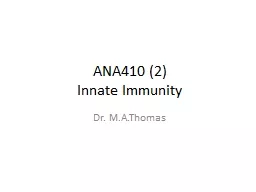

Dr MAThomas FUNCTIONS OF THE IMMUNE SYSTEM Recognize destroy and clear a diversity of pathogens Initiate tissue and wound healing processes Recognize and clear damaged self components ID: 928963
Download Presentation The PPT/PDF document "ANA410 ( 2) Innate Immunity" is the property of its rightful owner. Permission is granted to download and print the materials on this web site for personal, non-commercial use only, and to display it on your personal computer provided you do not modify the materials and that you retain all copyright notices contained in the materials. By downloading content from our website, you accept the terms of this agreement.
Slide1
ANA410 (2)Innate Immunity
Dr.
M.A.Thomas
Slide2FUNCTIONS
OF THE IMMUNE SYSTEM
:
Recognize
, destroy and clear a diversity of pathogens
.
Initiate
tissue and wound healing processes
.
Recognize
and clear damaged self components
.
Exhibit
“tolerance” to innocuous material including self
Slide3The
Normal Immune
Response
Definition: Defense
against infectious
pathogens
Innate immunity refers
to defense mechanisms that
have evolved to specifically recognize microbes and protect individuals against infections
.
Adaptive immunity consists
of
mechanisms
that are stimulated and are
capable
of
recognizing microbial and
nonmicrobial
substances
Slide4Innate
immunity
The
first line of
defense
always ready to prevent and eradicate infections.
Adaptive
immunity Develops
later
- after
exposure to
microbes
- more
powerful than innate immunity in
combating
infections
.
By
convention, the term “immune response” refers to adaptive
immunity
Slide5Innate and Adaptive immunity represent two different arms of the immune system that work together in host defence
.
Innate
Immunity (natural/native
):
I
mmediate
protection from
infection
B
roadly
specific to microbes and tissue damage
products
Does
not change in response to reinfection (
non-adaptive)
Initiates
processes that lead to activation of adaptive immune responses
.
Slide6Adaptive
Immunity (specific/acquired):
Appears to adapt to a variety of non-self components (acquired)
Is highly specific to a particular molecule “antigen”
Responses upon reinfection are faster, better and stronger (memory)
Generates proteins and cells that enhance innate immune function.
Slide7INNATE IMMUNITYM
ajor component -
epithelial
barriers that
block entry of
microbes
Epithelia of
the skin and gastrointestinal and respiratory tracts provide mechanical barriers
Produce
anti-microbial molecules such as
defensins
Lymphocytes
located in the epithelia combat microbes at these
sites
If
microbes do breach epithelial boundaries, other defense mechanisms are
called in
Slide8Slide9Slide10Slide11The two most important cellular reactions
of
innate immunity:
Inflammation
, the process in which phagocytic leukocytes are recruited and activated to kill microbes
.
Anti-viral
defense, mediated by dendritic cells and NK cells
.
Slide12Slide13Slide14Slide15Leukocytes and epithelial cells that participate in innate immunity are capable of recognizing components of microbes that are shared among related microbes and are often essential for the infectivity of these pathogens.
Slide16How are things
recognised
These microbial structures are
calledpathogen
associated molecular patterns (PAMPs). Leukocytes also recognize molecules released by injured and necrotic cells, which are sometimes
calleddanger
-associated molecular patterns (DAMPs). The cellular receptors that recognize these molecules are often
calledpattern
recognition receptors. The best-defined pattern recognition receptors are a family of proteins
calledTo
l l-like receptors (TLRs)that are homologous to
theDrosophilaprotein
Toll.
Slide17Slide18Neutrophils
F
irst
responders of
the
defense
system
R
apidly
localize to areas of acute
infection
P
hagocytize bacteria
C
ytoplasmic
granules contain
proteases
C
apable
of generating reactive oxygen intermediates to kill the invading
organism
M
ost
abundant white blood cell in circulation
H
alf
life of only 1-2 days.
Slide19Slide20Slide21Slide22Slide23Slide24Innate immunity- Summary
Recognition
of
Microbes by
the
Innate
Immunity
system
Components,
• E
pithelial
Barrier
• Phag
ocytes
:
Neulrophil
s
and
Mo
nocytes Macrophages
• Natural Kill
er
cells
• Th
e Co
mplement System
•
Cyt
okines
o
f Innat
e
Immun
ity
• Oth
er Plasma Proteins of Innate ImmunityEvation of Innate Immunity by MicrobesRole of lnnate Innate immunity In StimulatingAdaptIve Immune Responses